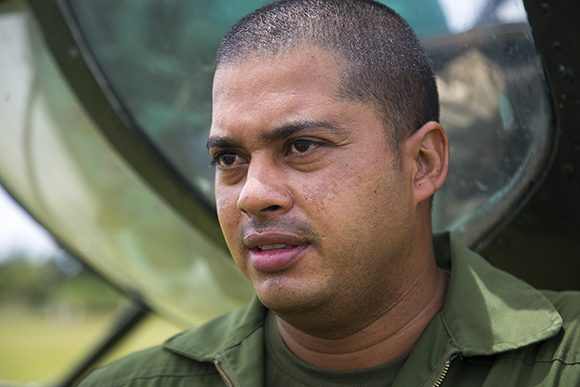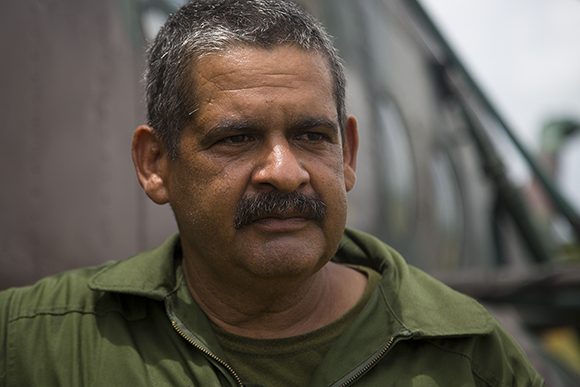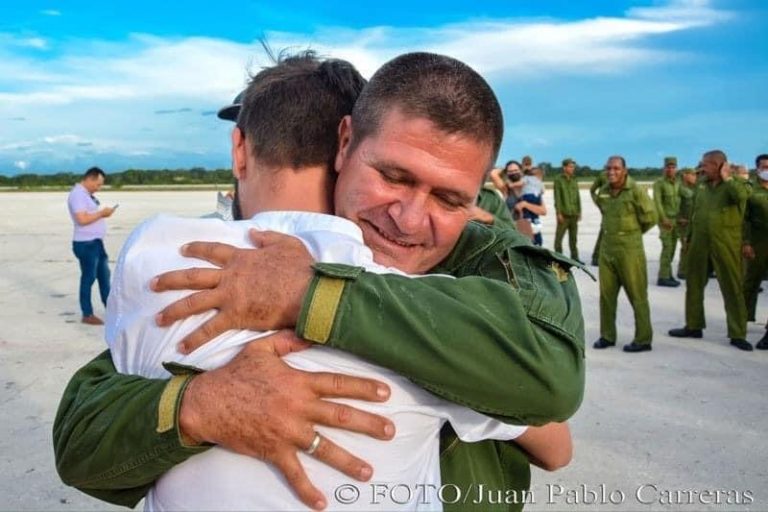 By: Andy Jorge Blanco, Irene Pérez
By: Andy Jorge Blanco, Irene Pérez
(Special envoys of Cubadebate)
As soon as he enters the helicopter cabin, the pilot Aniel Santiesteban Alberteris puts on a life jacket and establishes communication with Bahía Control, from where he directs each air operation at the scene of the incident.
–Control Bay. H-141 taking off from the platform for the water intake.
Next to him, co-pilot Dairon González Espinosa signals to the flight instructor. Emerson Infante García has already checked the working parameters of the aircraft, engines, temperature, gases, oil. The blades of the MI-17 of the Air Force begin to turn and cause the grass, from where the machine rises, to move incessantly, raising the dust of the esplanade, like a whirlwind.
A bambi bucket hangs below the helicopter, an accessory with a maximum capacity of 2,500 liters of water. Since the fire broke out at the Matanzas Supertanker Base, several aircraft of the Revolutionary Armed Forces have flown over the area of the incident. While firefighters attack the fire from various points on the ground, Cuban helicopters do it by air, pouring water. They come and go from the fire to the bay, from the bay to the fire.
 Pilot Aniel Santiesteban. Photo: Irene Pérez/ Cubadebate.
Pilot Aniel Santiesteban. Photo: Irene Pérez/ Cubadebate.
Lieutenant Colonel Aniel Santiesteban explains how they carry out each of the operations:
“On the ground there is a pointer, who directs aviation and is a vital task. They send you in or out. Hold on. Watch out for the left. Caution on the right. An obstacle. They have a tank up front. an antenna. And they give you all that information.
“Riding in this type of exercise is very complex. We approach a meter from the water. The aircraft has an air power that creates a whirlwind. All the windows fog up. Practically the operation is carried out according to the instructions given by the technician to start the ascent or to descend a little more. The bambi bucket is operated and prepared by a weapons engineer who is also part of this type of preparation.
“That bucket has to reach the bay, make contact with the water, turn, fill and hang vertically to start the ascent, and then throw the water on the fire.”
Within two hours and thirty minutes, when they land at the Army General Staff, the crew will have made 30 emissions above the flames, which is equivalent to 75 tons of water in just one morning to put out the fire.
***
On Friday night, Aniel, Dairon and Emerson received a call from headquarters with the mission of extinguishing the fire at the Matanzas Supertanker Base. Aniel celebrated that day the 30 years of his wedding with Rebeca and had to get ready to go out first thing on Saturday.
From Military Unit 3710 of the Eastern Army Air Force, in Holguín, he took off the crew at dawn, and in the first light of day he surprised them while they were flying over Varadero. A few minutes later they arrived at the General Staff in Matanzas, enabled the aircraft and left on the first flight to the fire.
At 35 years old, the oldest Dairon González Espinosa confesses that reality always surpasses any image:
“When we fulfilled that first mission, we realized that the magnitude that we imagined was too small compared to the flames. There were columns of smoke that reached 3,000 meters in height. And a wingspan of about a kilometer. And the flames soaring. A very great experience. Seeing all the fire trucks that were buried there, debris on the flames, that’s something hard, unforgettable.”
 Major Dairon Gonzalez Espinosa. Photo: Irene Pérez/ Cubadebate.
Major Dairon Gonzalez Espinosa. Photo: Irene Pérez/ Cubadebate.
A thick column of black smoke made it difficult for them to maneuver in the air and, at times, reduced visibility. The chemical substances that emanated from the combustion of crude oil penetrated into the cabin. That same day, the Ministry of Science, Technology and the Environment (CITMA) reported that there were approximately 3,200 particles in the air. The cloud of smoke contained sulfur dioxide, nitrogen oxide, carbon monoxide, among other substances that were concentrated five kilometers high. The helicopters of the Cuban Air Force passed through there.
In the afternoon, a WhatsApp message moves me: “I am aware of everything and I hope this will end soon. My dad is over there too, he’s one of the helicopter pilots. Aniel is called, like me. I’m with the balls in the throat, but pa’lante. If they are there, risking it, you have to be strong”.
Nobody knows at that time, but when the Holguín crew returns to the Eastern Army base, they will have carried out more than 135 flight missions over the flames of the most important fuel reservoir in all of Cuba.
***
Lieutenant Colonel Aniel Santiesteban points out that, in order to face a scenario as complex as the one experienced in Matanzas in the first days of August, the crew receives prior preparation: “This is one of the exercises that requires the most professionalism and experience, since the water intake is carried out at very low heights above the surface of the sea and the launch is over areas with very complex situations, fires and the presence of chemical substances”.
He immediately adds that it is a team and that it is unfair to mention only the pilots or heads of the ship. “Emerson is the flight instructor, who tells us ‘launch, go down, go down, go down’, with the water there, a meter away. If this machine flies, it is thanks to a team that is on the ground, made up of technical assurance, engineers and aviation, who prepare and get the machine ready with all the liquids and fuel”, he says.
After filling the bambi bucket that hangs from aircraft H-141, the machine ascends to approach the flames.
 Emerson Infante García es instructor de vuelo. Foto: Irene Pérez/ Cubadebate
Emerson Infante García es instructor de vuelo. Foto: Irene Pérez/ Cubadebate
Instructor Emerson Infante García indicates where to launch according to the points that, from the ground, the pointer needs. There are more than four Revolutionary Air Force helicopters doing the same job. At times, the flames exceed 100 meters in height. And you have to go down, with the fire almost touching the landing skids.
Multiple aircraft fly over simultaneously. Each one of the crews observes the airspace constantly. “The one that goes ahead alerts us, the one that goes behind also and in this way we help each other. We give each other feedback,” says Aniel.
***
On Thursday afternoon, 144 hours after the explosion of the first tank at the Matanzas Supertanker Base, Aniel, Dairon and Emerson’s aircraft landed in Holguín. On the networks I see a photo of the older Dairon, kissing his wife and his two-year-old girl. Hours before concluding his mission in Matanzas, he had told us about his three children, the eldest who turned 12 on Monday and who asked him about the fire and if he was putting on the gas chamber. He had told us about the other boy, five years old, and the youngest, two, whom he carries in one of the photographs.
I also see another image, of the two Aniel, father and son.
–I saw that the old man is already in Holguín –I write to him.
– He just landed. Here I am with him – he answers and sends me another photo of the two of them, embracing.
